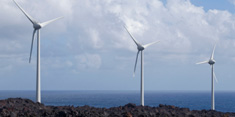Early civilizations could not help but notice the power of a roaring wind. They found a
way to channel this force by attaching sails to their boats. Ancient fleets plied the
Mediterranean, augmented by oars to help control direction and speed. Navel battles
determined the course of empires.
Aware that sails could drive boats, Persians adapted them in constructing the earliest
known windmills, in the sixth-to-eighth centuries A.D. They mounted pieces of cloth to
a framework of reeds around a vertical shaft. When winds blew strong, this machine
rotated parallel to the ground and produced enough power to grind grain. Because the
wind that filled sails in one direction also worked against the sails that were returning in
their rotation, this design was somewhat inefficient.
Windmills began to dot medieval Europe around 1300AD, with a singular change in
design: Blades were mounted to an upright wheel that turned around a horizontal
wooden shaft. Builders probably got the idea for a vertical wheel from water wheels,
long in use beside streams.
Windmills were the engines of pre-industrial Europe, supplying clean energy for
pumping water, grinding grain, draining dykes, milling lumber, making pigments, and
processing spices. The Dutch constructed all-in-one “tower mills,” fortress-like buildings
with a post mill on the uppermost story and a grindstone, storage rooms, and living
quarters on floors below.
With the rise of steam power around 1800, windmills fell into disfavor in Europe, but
developments continued in the United States. In 1854 Daniel Halladay of Connecticut
created a windmill that turned automatically toward whatever direction the wind was
blowing and that slowed itself down in high winds. By 1888 manufacturers were
replacing fragile wooden construction with blades of galvanized steel.
Windmills played a major role in settlement of the American West. Across the vast semiarid
landscape, windmills pumped water to slake the thirst of livestock, railroads and
incipient towns.
Phyllis Mckenzie
Sources Consulted
- Handbook of Texas Online, s.v. “Windmills,”
http://www.tshaonline.org/handbook/online/articles/WW/aow1.html (accessed April 10, 2009).
- “Illustrated History of Wind Power Development, Part I: Early History Through 1875.”
TelosNet Web Development and Darrell Dodge, 1996-2001.
http://www.telosnet.com/wind/early.html (accessed April 10, 2009).
- Watson, John. “The Windmill: Yesterday/Today/Tomorrow (From grinding corn to
pumping water to generating electricity),”
http://buckcreek.tripod.com/windmill.html (accessed April 10, 2009).
- Wikipedia, s.v. “Windmill,” http://en.wikipedia.org/wiki/Windmill (accessed April 9,
2009).

